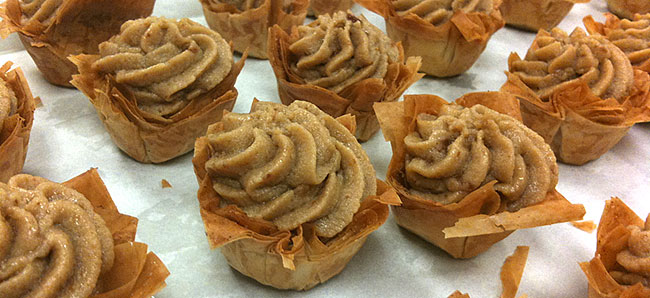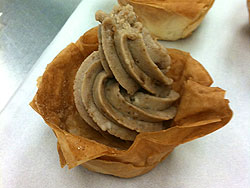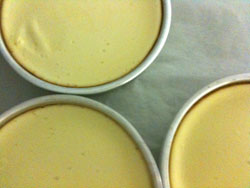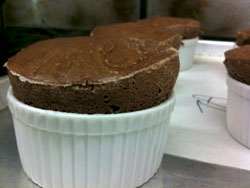
This week in baking class we covered Cheesecakes and Souffles. I’ve made a few cheesecakes before, but never a souffle. I don’t think I have even had a dessert souffle before. This was originally scheduled for last week, however, our instructor was sick. Luckily the schedule for the class has a built-in make up day so we still get to cover all the planned topics, just a week later.
Cheesecake is really a custard (cooked milk, sugar, and egg yolk mixtures) with a bottom crust. The crust can be composed of nearly anything; graham cracker, spices, nuts, Oreos, you name it. If the crust is just on the bottom the sides may turn brown and if the crust partway up the side of the custard it is sometimes difficult to keep it there. Partially baking a crust before the final baking with the custard in the form will produce a crisper crust.
The filling can be made the day before and refrigerated. The process of making the custard is similar to creaming. Using a paddle attachment, we don’t want air in this, soften the room temperature cream cheese well, add the sugar (the sugar loosens the cream cheese when its mixed in), each egg at a time and finally the flavorings. Scrape the bowl often for consistency, make sure bottom is scraped.
There are many different ways to bake a cheesecake, its best to follow the recipe. Springform pans don’t need parchment paper, butter crusts create enough oil for easy release. A recipe that uses a high temperature at first and then reduces it sets and then bakes custard. Convection ovens are not a good choice for cheesecake or any gentile custard, it will brown them too much. Cracking is caused by not mixing enough, over mixing but mainly from over baking. The middle of the cake should still move a little when it comes out, if it does not you have over baked the cake. The custard will continue to bake outside of the oven during the cooling process. If using a water bath use large foil, do not piecemeal the foil together or liquid will get into your cheesecake.
Souffle is French to breathe or blow. A soufflé is a light, fluffy, baked cake made with egg yolks and beaten egg whites combined with various other ingredients and served as a savory main dish or sweetened as a dessert. Every souffle is made of two parts, pastry cream enhanced with flavoring and French meringue (sugar and raw eggs). These are baked in a ramekin. Its very important not open the oven at all during the baking process or it will fall. Souffles need straight-sided containers that are coated (butter and sugar or butter and hard cheese etc) in order to allow the batter to get height during the baking process. A sauce is usually served on the side.
Some rules for souffles
- Avoid over deleting the base, it needs the structure of the pastry cream.
- Whip the egg whites correctly to soft peaks.
- Fold meringue in well, work fast and take control its not that gentile.
- Fold in meringue with a large spatula
Heres what we made today:
 Cheesecake in Phyllo Cups
Cheesecake in Phyllo Cups New York Style Cheesecake
New York Style Cheesecake Chocolate Souffle
Chocolate Souffle
6 Comments
I was wondering what was in those phyllo cups. Looked like mashed up banana bread in some liquid form. Interesting about the baking of cheesecake. Not that I have made many, but they always crack. I definately have overbaked them because I thought that they needed to be fully set in the middle.
The teacher said there are lots of reasons it could crack – Martha says to not scrape the bowl after adding the eggs (even when poring it into the spring form pan). I think my teacher would rather you just mix it the right way in the first place and then it wouldn’t matter if you scraped it because there would be no lumps stuck to the sides of the bowl, besides being wasteful, cream cheese is expensive so I tend to agree with my teacher – especially if your running a business.
Yeah the filling on those is cheesecake that you make on a sheet pan and then mush together when its done and pipe with a pastry bag into the phyllo cups. We flavored it with chocolate hazelnut which had a brown color. The cups are made in a cupcake pan – they are easy to make too.
Did you make the phyllo dough? I’ve wanted to try different pastries but it seems like now everyone just buys phyllo or puff pastry when they aren’t doing regular pie crust. Someone had to make it by hand once and if it’s not too hard I’d like to learn how.
I used the pre-made. I want to try making my own, but don’t have the right equipment. I’d like a pasta machine to do it with though – the long rolling pin way looks like a skill I’m not sure I have (yet). Plus the rolling pin won’t get it as thin as the pre-made or pasta roller method.
I watched phyllo being made on TV once. It was huge sheets…like 5×5. They were masters at stretching it just to the right point. I have no desire to make it myself when it can be purchased. I am pretty sure I would just be disappointed if I made it myself.
I’ve made LOTS of souffles in school and at home. Upon my instructor’s recommendation, I started using a balloon whisk to fold in my egg whites instead of a spatula, as it helps to incorporate air back into your filling. I’ve been applying this every time I need to fold in anything that’s been whipped and I’ve noticed a difference.